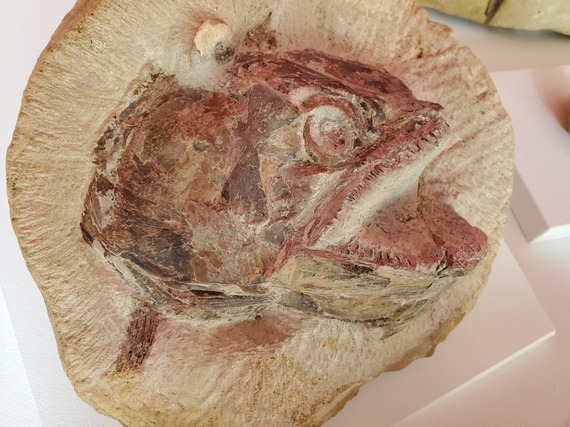
A rare collection of nine beautifully preserved fossil fish - including an eye-popping pachycormus fish in three dimensions - is on public display for the first time at Stroud’s Museum in the Park.
The early Jurassic marine fossils date from about 183 million years ago, when much of what is now Britain was a tropical sea and dinosaurs roamed the land.
The finds on display were discovered in 2022 at Court Farm in Kings Stanley by fossil hunters Dr Neville and Mrs Sally Hollingworth and a team of experts.
They show an entire food chain frozen in time: from an ichthyosaur which would have eaten larger fish like the eye-popping pachycormus, to smaller fish, ammonites, and squid-like belemnites. Further evidence of the food chain can be seen in their fossilised droppings (coprolites) and in one case, from its stomach contents.
It is exceptionally rare to find such well-preserved marine specimens. Delicate creatures like fish are often flattened in the fossilisation process - if they fossilise at all - but here scales, fins and even eyeballs can be clearly seen.
The remains of the creatures have been protected from the pressure of rock above them by hard mineral layers known as concretions and nodules which built up around them after death.
Kevin Ward, Manager at Museum in the Park said: “The original discovery of these fossils attracted worldwide interest, so we are delighted that the Museum in the Park is able to display nine of the specimens for the public to view for the first time.
“We’re very grateful to Sally and Neville Hollingworth for loaning the incredible three-dimensional Pachycormus fish which looks like it’s jumping out of the rock with bulging eyes and teeth bared and has been a favourite with visitors so far.”
Sally and Neville added: “It is extremely unusual to find such rich and exceptionally well-preserved fossils like the fish skull preserved in 3D. Most of them are crushed flat by pressure. Rocks of this age in the Cotswolds have produced fossils like these from quarries in the 19th Century that have now long gone, and we are delighted Adam Knight of Court Farm has kindly allowed us to excavate this incredible fossil rich site for scientific research. Then to see material from farm to museum feels a great achievement.”
Fossil Fish From the Jurassic Seas is on display at The Museum in the Park until 29 September 2024. The Museum is open Tuesday – Friday 10am – 4.30pm; Saturdays, Sundays and Bank Holidays 11am – 4.30pm. The exhibition is free-of-charge, with donations welcome.
More information about the exhibition can be found on the museum’s website https://museuminthepark.org.uk/calendar/2024/6/11/display-fossil-fish-from-the-jurassic-seas
The fossils have been conserved by Nigel Larkin with Sally and Neville Hollingworth with the aid of a grant from the AIM Pilgrim Trust Conservation Scheme and the assistance of The Curry Fund of the Geologists’ Association www.geologistsassociation.org.uk.
The Museum in the Park, managed by Stroud District Council in collaboration with the Stroud District (Cowle) Museum Trust, is situated in a Grade II listed 17th Century former wool merchant’s house. The museum tells the extraordinary and diverse history of Stroud district and has over 4,000 objects and artefacts on display – from dinosaur bones to one of the world’s first lawnmowers.
Sign up for email alerts: https://www.stroud.gov.uk/apps/email-alerts
For regular social media updates from the council, follow us on Twitter, Facebook, Instagram and LinkedIn.

|